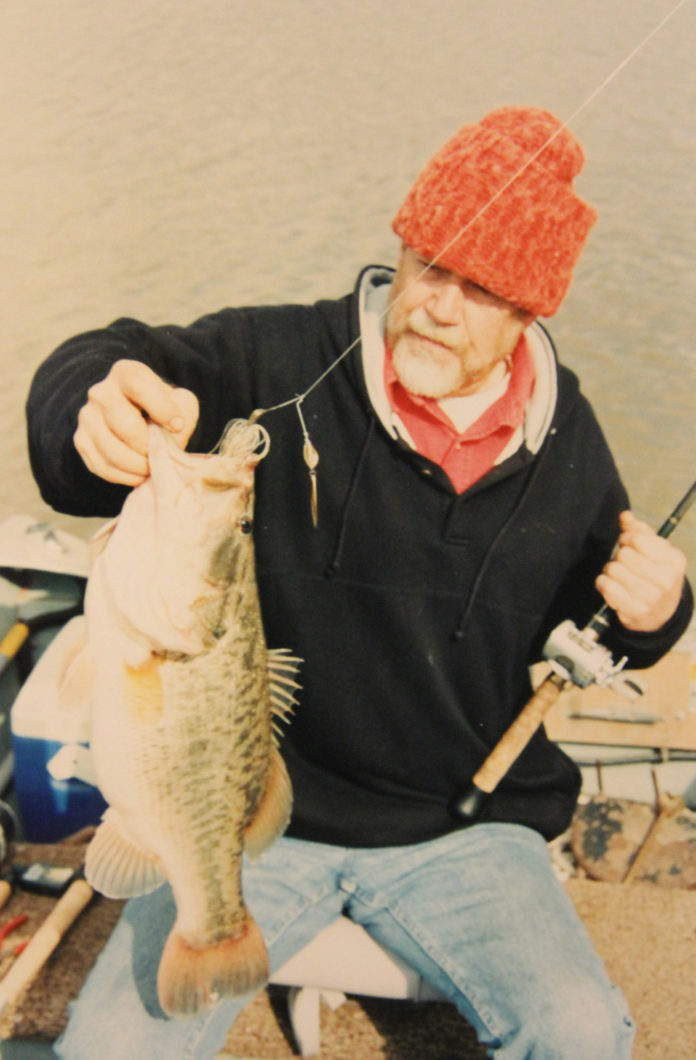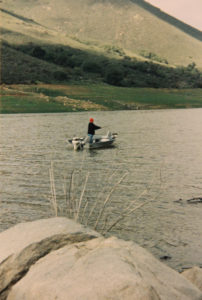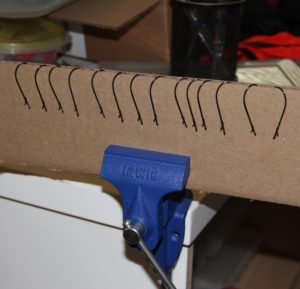
BY GEORGE KRAMER
While I ponder the thought of purchasing a real-time sonar/GPS and the apparent advantage it might bring, a couple of things come to mind — besides the financial hit. One, will my abilities to absorb the actual utilization (the technical procedures) and to believe what the units are telling me. And the other, more sentimental, that historically, one of the most important and successful bass fishermen in the West began his quest to understand structure fishing without any sonar.
Unfortunately, the publishing house that produced his book In Pursuit of Giant Bass went out of business, so a newer generation of anglers may not know the name Bill Murphy (Lunker Bill), who reigned for more than 30 years in San Diego
County. One could hardly find a single issue and never a year of archived copies of Western Outdoor News from the late 1960s through the mid to late 1990’s where his catches weren’t newsworthy nor impressive.

In the beginning, however, whatever he had heard of structure fishing or offshore bass fishing, needed to be confirmed in a most primitive way. Most veteran anglers and without saying, all new generation anglers, would never go to the same lengths to find out where drop-offs and channels ran or where rockpiles stood — with a rope and concrete anchor.
Yet that’s what Bill did, bouncing that anchor on the bottom, confirming or unveiling the nature of the bottom changes that he first sensed with his lures sinking or striking underwater terrain. My back hurts just thinking about leaning over the side of tin boat or wooden rental and lifting and banging the bottom and noting by length of rope for the depth.
That effort may have contributed to Bill’s reputation as occasionally cranky, when those early portable sonar units made their way to the City lakes. After the time he had put in, now anyone could drive around (and often drive around where he was anchored) and get a sense of where the “breaks” were. (Of course, that’s not what they were called back then, rather “drop-offs” was more common.)
But that’s progress. He did have a long, long run of dominance, and found many more substructures in away places as the crowds found the most prominent locations. Then later in his career, he switched to the “paper” style graphs and spent many more hours trolling offshore and identifying what he referred to as “populations” of bass that occupied different parts of the lake or water column and behaved differently.

His book, however, was primarily based on his years of fishing from a “fixed position” so his observations reflected this. I compare those to Bill Siemantel’s Big Bass Zone, who utilized a similar span of roughly 30 years, whose observations were made as a more mobile angler — and with a wider range of tools (lures.) They both offer perspective that is unlikely to be repeated. After all, what young fisherman do we know today who plans to take the next 30 years logging his experiences and observations to encapsulate all knowledge about catching bass?
Of course, he or she may not have to because real-time sonar and GPS technology doesn’t care about the back story. Frankly, it dismisses my more than 50 years of experiences on the water (often with the experts of the era) and says: “Just cast here or cast there.” And that’s why it’s so darn tempting.
USING WHAT WE HAVE
Bass fishing still has plenty of other considerations, even though location remains at the top of the list. You know, those practical issues like rigging, hooks and rod choices. Let me talk about one method — drop-shotting a plastic worm (or whatever). I speak form from my own experience, understanding, it may vary from your own favorite methods or the considerations of known experts out there.
Two things go particularly hand in hand: rods and weights (sinkers). Every time I try to alter my approach in the brushy or quagga-heavy lakes I fish, it doesn’t take long for me to get back to a 3/8-ounce sinker and a medium-heavy (with a tip leaning toward medium) spinning rod.
I use 3/8’s because I want the bait to get down quick, whether it’s 5 feet or 25 feet. I’m hoping, then, that its quick arrival near any fish will draw attention, and hopefully I get that bite very quickly, while I can still count on my line being fairly direct to the fish.
Frankly, I sometimes go to half-ounce in brushy, 5 to 15 feet of water. It’s “get down” quotient and tight line sensitivity is very high, but its major drawback is it can overpower the rod on the possible hookset. On those I-think-I- had-a-bite scenarios, that weight will delay your driving the hook if it really is a fish and will almost always mean a hang-up if it isn’t one.
Unfortunately, not all rod makers mean the same thing when they say “medium heavy.” I use a Daiwa Tatula shakey head rod (called medium heavy) and also the older EVA-handled Tatula medium heavy. My team partner (son Mike) uses the XT series, an inch shorter medium-heavy model. The three 7-foot models are markedly different.
The shakey head rod is powerful (great for pitching), but it’s tipless for the drop-shot shake. The Procyon is stiffer than the straight medium, with more butt power, but not as sensitive. Yet my son’s rods are scary sensitive for a $99 rod. When he couldn’t make a trip, I pulled out his, rigged just like I always do, and I thought I was on a different lake.
The 3/8-ounce sinker holds the bottom and the flex in the tip means keeping bottom contact, while getting lots of worm “action” the way we work a bait (paddle ball style). When you stop feeling the “ball,” you start reeling.
The thing I’m much more willing to adjust is the height of the hook over the sinker, usually referred to as “leader length.” I’ve tried to correlate hook height with bait, weed growth and water temperature and only the latter is consistent. Cold water: shorten the length (and slow down).
Logic says, a very long leader keeps your bait up out of the grass. Except, we usually cast away from the boat (or bank) and now the bait is not 18 or 30 inches above the bottom. It’s down in the grass or moss, especially the longer your cast.
And what if the bait is free-swimming over a hard bottom? Higher seems better, but nothing falls up on our planet, and bass seem completely willing to pick up shad imitations wiggling right on the bottom — like dying shad. In other words, you’ll have to make those command decisions as your confidence or experience sees fit.
Other than that, I’ve also started to take a little time prepping my hooks for my on-the- water convenience. If you use ReBarb hooks, you’ll notice you hook a few fish and the shrink-wrapped barb tends to slip around the hook shank. It probably doesn’t change the world, but I now take a couple of packs of new hooks and blast them with a hair dryer on high. It shrinks the barbs tighter and doesn’t damage them like you can if you put them over an open flame.
And that’s all I got right now.



